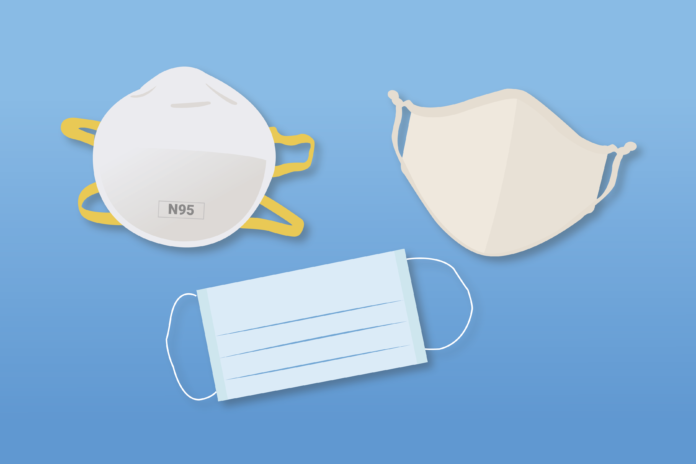Experts compare the efficacy of different masks in blocking particles
Although wearing masks in public has been common in some countries since before the pandemic, it was not until recently that masks have become a staple item in the U.S. Considering both the COVID-19 pandemic and the unhealthy air quality due to the recent wildfires in California, there are a myriad of masks to choose from that can mitigate both threats. Here’s what to consider when deciding what mask to wear:
N95 masks
N95 masks block 95% of particles up to 0.3 microns in size, according to You-Lo Hsieh, a professor in the department of biological and agricultural engineering. Compared to surgical masks, N95s have added filtration materials which provide further protection. Hsieh stated these masks block vapor droplets produced by humans when breathing, speaking or sneezing; these droplets can vary from small aerosol particles to much larger particles, up to hundreds or thousands of microns in magnitude. Santiago Barreda, an assistant professor in the department of linguistics, stated that there is variation among people as to how many particles they expel during these processes.
“The louder people talk, the more particles they put out,” Barreda said. “One way to help [reduce] the spread of coronavirus might simply be everybody just don’t talk so loud.”
Christopher Cappa, a professor in the department of civil and environmental engineering, emphasized that N95 masks are efficient due to their tight fit sealing around the face. If not worn properly, used in the wrong size, or worn with facial hair, the full potential of these masks cannot be realized.
Surgical masks
Hsieh stated that although N95 masks protect others as well as the wearer, the purpose of surgical masks is to mainly protect others, such that the particles a surgeon expels do not infect the patient while operating. Although N95 and surgical masks are made of the same fine synthetic fibers, surgical masks are less effective due to their looser fit.
“[For N95 masks], everything goes through the material rather than when you wear other face masks,” Hsieh said. “Homemade or surgical, a lot actually leaks around so they’re not as effective.”
Despite being less effective than N95 masks, Hsieh stated that surgical masks are still more effective than cloth masks because they are made of less-permeable fibers.
Cloth masks
In a recent study comparing the emission of particles while wearing different masks, Cappa found that it was difficult to determine the efficacy of cloth masks because they would shed additional particles from the material of the mask itself. In looking at cloth masks of differing material, Cappa stated they were highly variable in the amount of particles they shed.
“Especially for cloth masks, we want to be aware that material might come off of the surface of those masks as well, and so we want to be careful when we’re handling the masks,” Cappa said. “Especially if we’ve been wearing them in a very populated place where they might have gotten contaminated. We want to be careful, not shaking them around or just in general not touching the front of your masks as well.”
Although it is difficult to compare cloth masks, Hsieh stated that in general, more layers are better to increase filtration of particles. That being said, cloth masks are only able to block large particles because the pores of the material are large enough to let smaller particles through. For example, in terms of wildfires, cloth masks may be able to deal with ash particles, but cannot defend against the larger concern: PM 2.5. These particles are 2.5 microns or less in magnitude and can cause harm to the lungs. In addition to the material of cloth masks, the increased airflow along the sides of the mask suggest it is the least effective option.
While Cappa encourages people to continue to wear masks properly, he emphasized that they are not the only measures necessary to address pandemic concerns.
“Masks contribute to helping. They’re helpful, but they’re not 100% helpful,” Cappa said. “We have to wear masks while still practicing social distancing, both inside and outside. We can’t forget [to limit] the number of people who we come in contact with in general [and] limit time inside of crowded spaces. Masks contribute to the overall picture, but by themselves aren’t a perfect solution.”
Written by: Michelle Wong — science@theaggie.org




